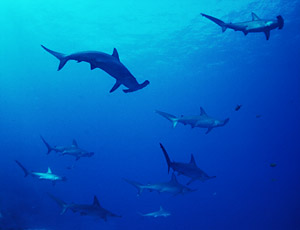![[Ocean Oasis Field Guide]](images/bnr-oo-field.gif)

![[Ocean Oasis Field Guide]](images/bnr-oo-field.gif) |  |
|
Sphyrna lewini 
Family: SPHYRNIDAE (Hammerhead sharks) DescriptionThe hammer-shaped lateral expansions of the head easily distinguish hammerhead sharks. The width of hammer in this species is 24-30% of total length. Its coloration is brownish gray, shading to white on the underside. At birth, hammerheads are about 42-55 cm (about 16-20 inches); adults can reach 4.2 m (nearly 14 feet) Range and HabitatHammerhead range is worldwide in tropical and warm temperate seas. Habitat is pelagic, but they also occur near shore, especially around seamounts or submerged reefs. Natural HistoryHammerheads have been observed in schools of hundreds of individuals around the top of seamounts and submerged reefs in the Gulf of California, the Revillagigedo Islands, and Cocos Island. Dr. Peter A. Klimley, an associate research behaviorist at the Bodega Marine Laboratory, University of California at Davis, has studied scalloped hammerheads for two decades at an underwater mountain, or seamount, known as "El Bajo" in the Gulf of California. Dr. Klimley believes that these aggregations occur only during the day, and that they come together for the purpose of selecting breeding partners. In a form of intra-sexual selection, the largest, physically fit, more fecund females force the smaller ones out of the center of the school. The males fight their way to the center of the school and once the selection is made for the dominant females, the pairs separate from the group to mate. The hammer shape of the head is thought to increase maneuvering ability, and also to increase their sensory capacities related to vision, smell, and pressure detection. Dr. Klimley believes their heads may be able to sense very minute variations in the magnetic field. When basalt hardens on seamounts, it makes magnetic ridges and valleys. Hammerheads may use these magnetic fields as a means for navigation. Although other scientist haven't yet confirmed this idea, it has not been dismissed. Hammerheads feed on other fishes, cephalopods, crustaceans, and turtles. The scalloped hammerhead shark is not generally considered to be aggressive toward swimmers and divers, but don't provoke it! Hammerheads can swim about a yard per second — and that is just the cruising speed.
For more information on Dr. Klimley's research go to:
http://www.pbs.org/wgbh/nova/sharks/masters/hammerhead.html
|
Text by Patricia Beller
Photograph from Ocean Oasis © 2000 CinemaCorp of the Californias
Field Guide |
Site Index |
Ocean Oasis Introduction
|
|
© 2000 San Diego Natural History Museum |